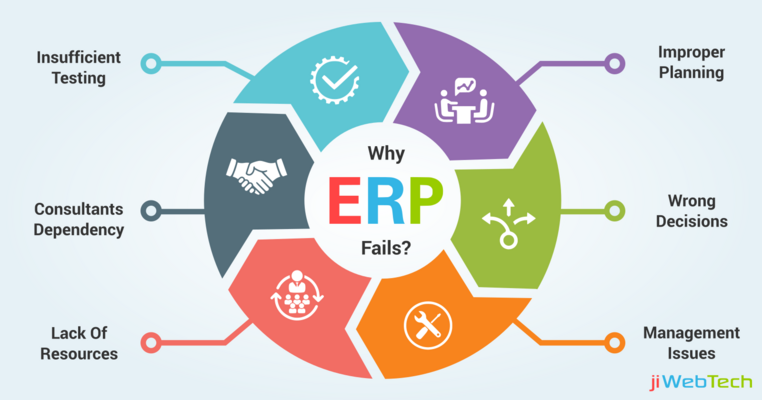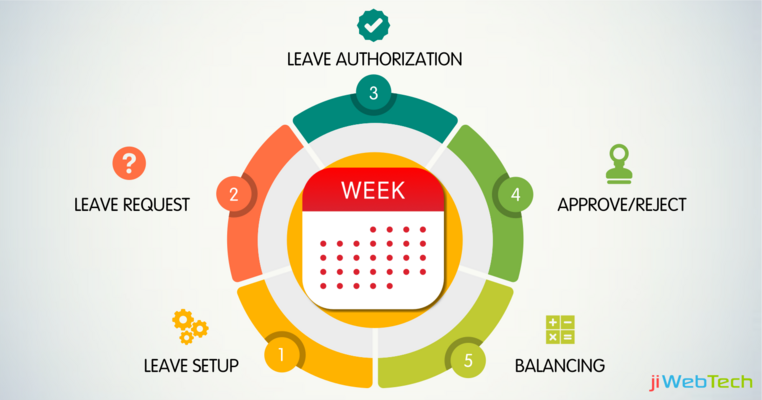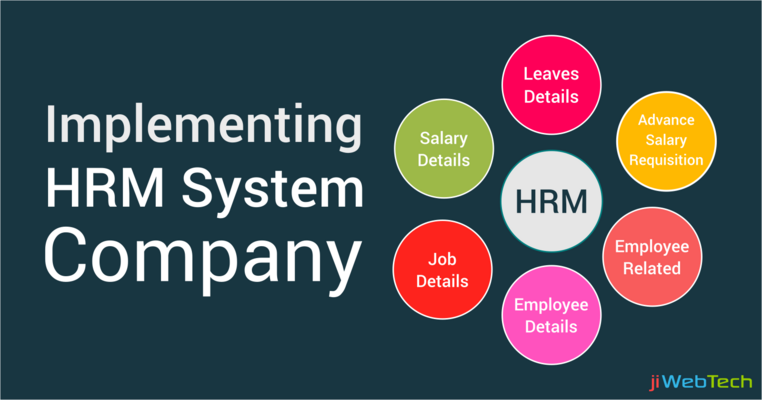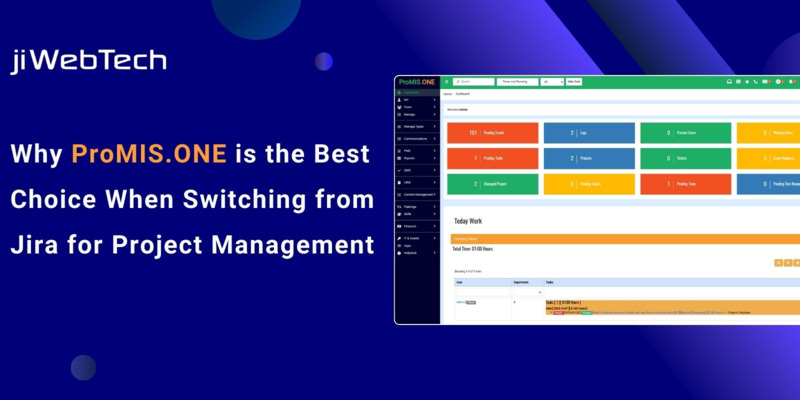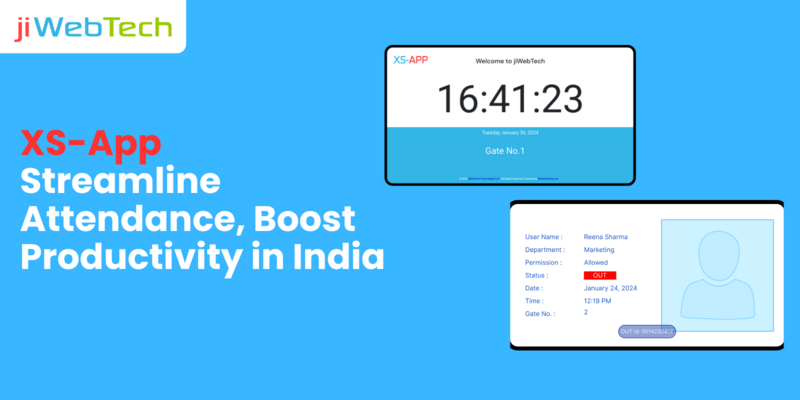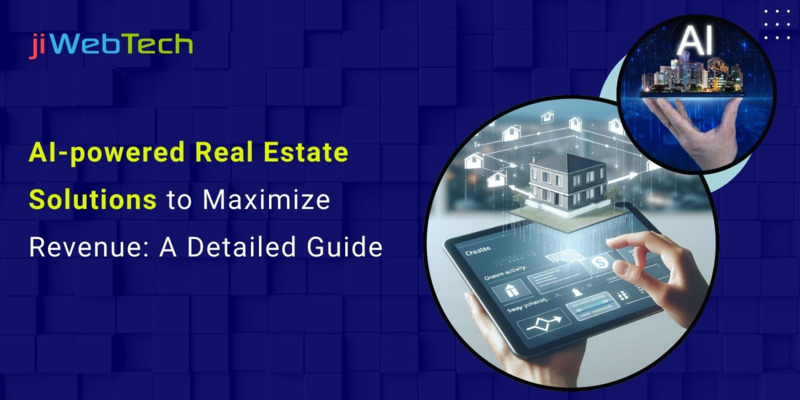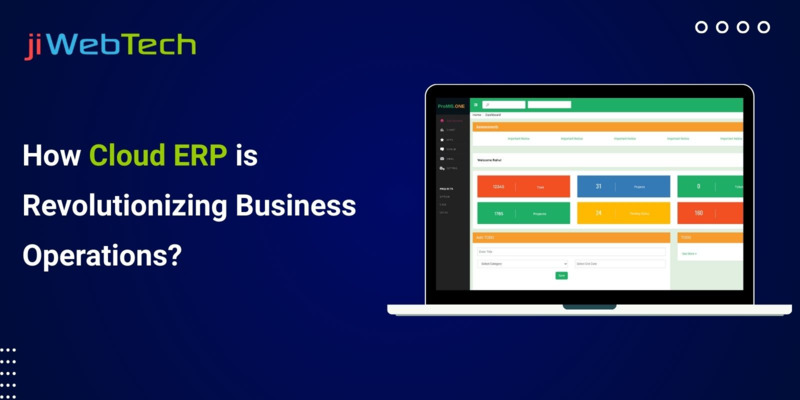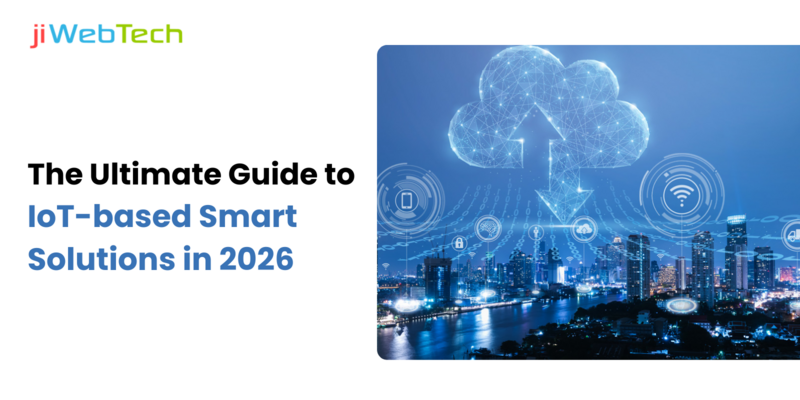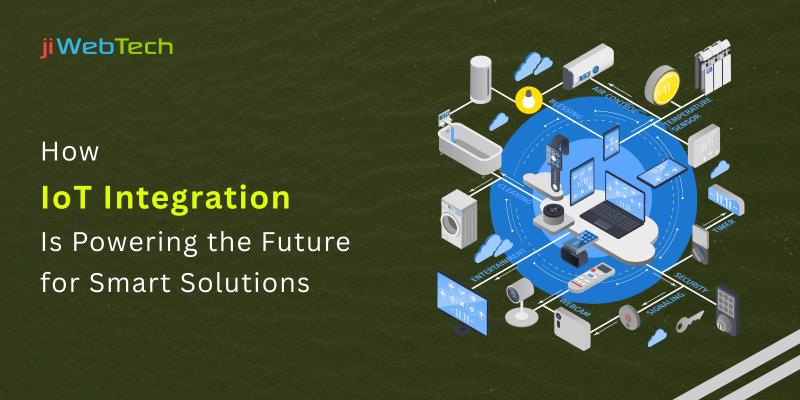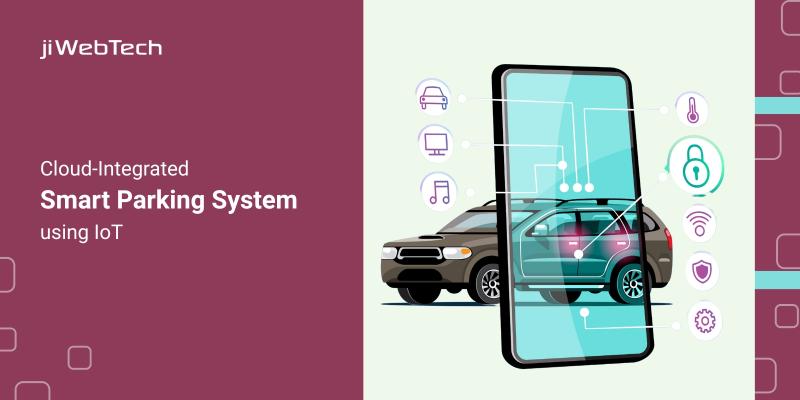- Oct 30, 2025
- IOT Solutions
- 747
Share this post on:
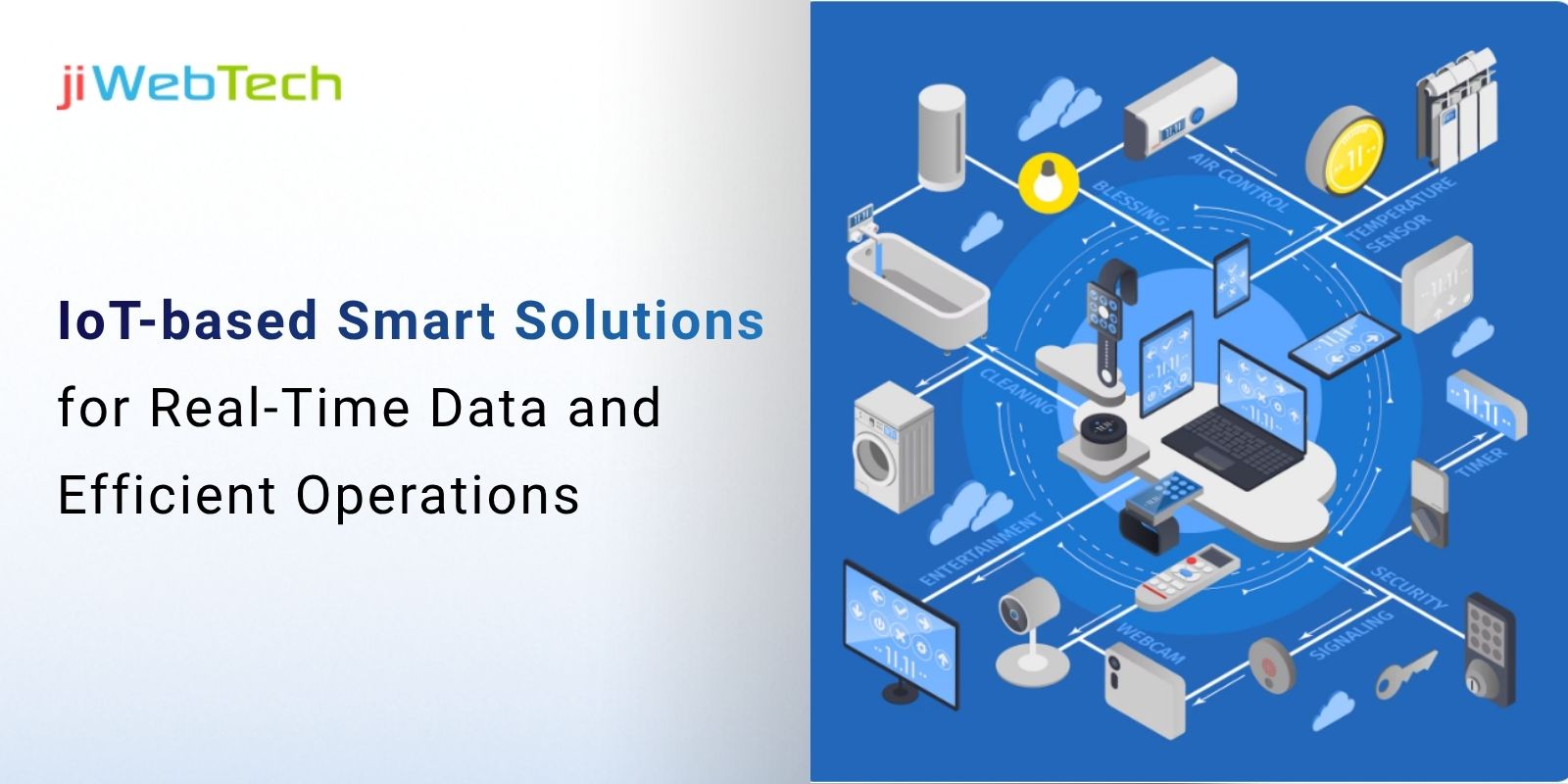
Have you ever wondered how industries are transforming their operations with the invisible network of connected devices called the Internet of Things (IoT)? How do smart devices manage to optimize everything from manufacturing lines to energy consumption in real-time?
Did you know that by 2026, the global IoT market size is expected to surpass $1.3 trillion, with over 18 billion connected devices actively shaping business efficiencies and consumer experiences? These questions reflect the transformative power IoT holds for real-time data utilization and operational efficiency across various sectors.
jiWeb Technologies: Driving Smart IoT Solutions
jiWeb Technologies stands out as a leader in harnessing IoT’s power to drive smart solutions tailored for diverse industries. Offering integrated ERP/CRM solutions combined with IoT-based smart systems, jiWeb enables businesses to operate more efficiently, with real-time data insights and automated operations.
Their offerings cover a spectrum from smart home automation to industrial monitoring and healthcare systems. With a focus on secure, scalable, and customizable IoT frameworks, jiWeb empowers clients to transition smoothly into connected ecosystems that enhance productivity, reduce costs, and improve service quality.
Through innovative IoT integration, jiWeb Technologies exemplifies how companies can leverage the ‘digital nervous system’ of devices and data connectivity to stay ahead in today’s competitive landscape. Businesses investing in jiWeb’s IoT solutions can expect streamlined communication, smarter resource management, and actionable intelligence that transform operations and customer engagement.
The Massive Surge in IoT Adoption
Enterprise spending on IoT solutions is increasing, with particular momentum in industrial IoT (IIoT) valued at around $275 billion for manufacturing, energy, and logistics sectors. Healthcare IoT is another booming domain, expected to reach over $594.5 billion, driven by remote patient monitoring and smart diagnostics.
This growth is fueled by advancements in connectivity such as 5G, edge computing, and artificial intelligence (AI), which enable rapid data transmission, reduced latency, and smarter data analytics. The vast network of sensors, actuators, and connected devices provides continuous streams of real-time data, which businesses harness to automate processes, predict maintenance needs, and optimize resource allocation for significant cost savings and performance improvements.
Key Benefits of IoT-based Smart Solutions
Let us take you through the key benefits of IoT-based smart solutions:
Enhanced Operational Efficiency:
One of the most impactful benefits of IoT is the ability to collect and analyze real-time data from connected devices. This continuous flow of information allows businesses to monitor processes, equipment, and environments instantly, improving operational visibility and control. For example, manufacturers utilize IoT sensors to track machine health, predict failures, and schedule maintenance proactively, reducing downtime by up to 50%. Similarly, logistics firms monitor vehicle locations, traffic, and delivery conditions in real-time to optimize routing and improve supply chain efficiency. Smart office and facility management systems automate lighting, HVAC, and security based on occupancy and environmental conditions, leading to smoother operations and energy savings. IoT-driven automation also reduces manual intervention in routine tasks like inventory management and quality control, minimizing errors and freeing employees for strategic activities. The net result is faster decision-making, reduced inefficiencies, and significantly enhanced operational efficiency across sectors.
Significant Cost Savings:
IoT technologies enable businesses to optimize resource use and reduce waste, leading to substantial cost savings. Smart energy management systems leverage sensors to monitor electricity and water consumption in real-time, dynamically adjusting usage to current demand. This has resulted in energy cost reductions of up to 30% for many enterprises. Predictive maintenance reduces expensive emergency repairs by fixing equipment issues before they cause failure. By extending the lifecycle of assets and avoiding production stoppages, companies improve their financial performance and asset utilization. IoT-driven inventory and supply chain management prevent stockouts and overstocking by providing accurate, up-to-the-minute information on stock levels and shipment conditions. This streamlines warehousing, reduces holding costs, and prevents spoilage or damage. These cost efficiencies are complemented by savings from process automation, reduced labor costs, and lower insurance premiums due to improved risk management.
Enhanced Customer Experience:
Businesses tapping into IoT gain deeper insights into customer behaviors, preferences, and usage patterns thanks to data collected from connected devices and sensors. This enables highly personalized products, services, and experiences tailored precisely to customer needs. For instance, retailers use IoT smart shelves and foot traffic sensors to dynamically adjust product displays and promotions based on real-time shopping patterns. In hospitality, IoT controls room environments (lighting, temperature) personalized to guest preferences, improving comfort and satisfaction. Healthcare providers use wearable IoT devices for continuous health monitoring, allowing remote consultations and customized treatment plans suited to individual patients. This targeted and responsive approach improves customer loyalty, engagement, and lifetime value by delivering meaningful, convenient interactions that adapt to changing customer demands.
Scalability, Flexibility, and Business Innovation:
IoT platforms are typically built with scalability in mind, allowing businesses to exponentially grow their connected device networks and data-processing capabilities without disruption. Cloud integration and edge computing ensure businesses can handle large IoT deployments and complex analytics on demand. This scalability offers the flexibility to continuously innovate. Organizations can experiment with new IoT-enabled products and services or adopt emerging IoT trends like digital twins—virtual replicas of physical assets to simulate operations and optimize processes. IoT also fuels innovative business models such as product-as-a-service, where companies remotely monitor and maintain products, shifting revenue streams to service-based models. By leveraging IoT-driven data insights and automation, businesses maintain agility to adapt quickly in fast-changing market conditions, securing a stronger competitive advantage.
Improved Sustainability and Environmental Impact:
Sustainability is a critical focus for modern businesses, and IoT smart solutions play a vital role in advancing environmental goals. IoT sensors track energy, water, and material consumption accurately, identifying inefficiencies and enabling reductions in waste and emissions. Smart cities use IoT for traffic management, reducing congestion and lowering CO2 emissions. Industrial IoT helps manufacturers optimize processes to minimize pollution and waste output. By enhancing resource efficiency and minimizing operational waste, IoT supports corporate social responsibility initiatives and helps meet increasingly stringent environmental regulations while generating cost savings.
Enhanced Security and Risk Management:
Although IoT introduces new security challenges, advances in cybersecurity and data encryption have improved the safety of IoT deployments. Businesses use these technologies to secure sensitive data collected from devices and prevent unauthorized access or attacks. IoT also enables real-time monitoring of assets and environments, providing early warning of potential threats, accidents, or system failures. In regulated industries like healthcare and food logistics, IoT facilitates compliance through continuous monitoring of product conditions and equipment status. These capabilities reduce operational risks, improve safety standards, and limit liabilities, building greater trust with partners and customers.
Greater Productivity and Workforce Empowerment:
By automating routine, manual tasks, IoT frees employees to focus on higher-value strategic activities. Connected devices can collect data, monitor equipment, and execute simple commands autonomously. This acceleration of workflows increases overall productivity. Furthermore, IoT facilitates remote working and monitoring, allowing management and technical personnel to oversee operations and address issues from anywhere, boosting workforce flexibility. IoT also improves workplace safety by monitoring conditions and alerting workers to hazardous situations, reducing incidents and associated costs.
Cost to Develop IoT-based Smart Solutions
The cost of developing IoT-based smart solutions depends on multiple interconnected factors that influence hardware, software, connectivity, security, and overall project complexity. Major cost drivers include the types and quantity of devices used, software complexity, data volumes, security compliance, and user experience requirements, among others. Understanding these factors helps businesses accurately estimate budgets and optimize IoT investments. Cost can vary dramatically depending on project complexity, scale, and features. Below is a general cost range for different IoT project categories:
Project Type | Hardware Cost (USD) | Software Development Cost (USD) | Connectivity & Infrastructure (USD) | Security & Compliance (USD) | Testing & Maintenance (USD) | Total Estimated Range (USD) |
Simple IoT Project | $5,000 – $15,000 | $20,000 – $40,000 | $2,000 – $5,000 | $1,000 – $3,000 | $5,000 – $8,000 | $33,000 – $71,000 |
Mid-Level Project | $10,000 – $30,000 | $50,000 – $80,000 | $5,000 – $15,000 | $3,000 – $7,000 | $10,000 – $20,000 | $78,000 – $152,000 |
Enterprise-Grade | $30,000 – $100,000+ | $100,000 – $250,000+ | $15,000 – $50,000+ | $7,000 – $20,000+ | $20,000 – $50,000+ | $172,000 – $470,000+ |
Key Cost Factors in Developing IoT Solutions
Here are the key cost factors that define the development cost of IoT solutions:
1. Hardware Components: Hardware forms the physical backbone of IoT systems. This includes sensors, microcontrollers, gateways, communication modules, and sometimes custom-built devices.
- Sensor Types: Costs vary depending on sensor types—temperature, humidity, motion, GPS, optical, etc., each with varying prices.
- Volume of Devices: The number of deployed units influences bulk purchase discounts but also increases overall cost.
- Customization: Off-the-shelf devices are cheaper but less flexible; custom hardware drives up design and manufacturing costs.
- Durability Requirements: Industrial or outdoor environments require rugged, certified hardware, which increases expenses.
2. Software Development: Software integrates connected devices with cloud or on-premises backends and user interfaces (web or mobile apps).
- Firmware: Embedded software inside devices that manages data acquisition and communication.
- Backend Systems: Server infrastructure for data collection, storage, and processing—often leveraging cloud services.
- Frontend Applications: User dashboards and mobile apps to control and visualize IoT data.
- Advanced Features: Analytics, AI, machine learning, and automation enhance functionality but increase development time.
3. Connectivity and Network Infrastructure: Connectivity options—Wi-Fi, Bluetooth, Zigbee, cellular (4G/5G), LPWAN (LoRaWAN, NB-IoT)—affect data transfer reliability and costs.
- Data Transmission Costs: Cellular or LPWAN networks incur recurring charges.
- Infrastructure: Gateways, routers, and edge computing devices may be needed to relay or preprocess data.
- Network Scalability: Supporting thousands of devices requires a robust, scalable architecture.
4. Security and Compliance: IoT systems must safeguard data integrity and privacy through encryption, authentication, and regular security audits.
- Encryption protocols and secure hardware modules add cost.
- Compliance with regulations (GDPR, HIPAA) requires additional development and documentation effort.
5. Testing, Maintenance, and Support: Extensive testing ensures the system's reliability, usability, and performance under variable conditions.
- QA and beta-testing consume resources to debug and optimize the IoT solution.
- Ongoing maintenance (software updates, hardware servicing) usually accounts for 15–20% of initial development costs annually.
Conclusion: The Future is Smart and Connected
The adoption of IoT-based smart solutions is no longer optional but essential for any business aiming for efficiency and real-time responsiveness. With billions of connected devices generating continuous data streams, companies gain unprecedented opportunities for insights-driven decision-making and automation that dramatically improve operational performance.
The real-time capabilities of IoT form the backbone of this transformation, enabling predictive maintenance, optimizing energy use, enhancing supply chains, and personalizing customer experiences.
Choose jiWeb Technologies to develop a secure, scalable, and innovative smart solutions for the businesses globally. Investing in IoT today means paving the way for a smarter, more productive future where data is the catalyst for operational excellence and sustainable growth. Embrace the future of business with jiWeb Technologies and let IoT powered smart solutions drive your success.
Frequently Asked Questions
1. What are the main factors that determine the cost of developing an IoT smart solution?
The cost is primarily influenced by hardware selection (types and quantities of sensors), software complexity (firmware, backend, analytics, and user apps), connectivity infrastructure (Wi-Fi, cellular, LPWAN), security and compliance requirements, data volume and processing needs, UI/UX design, and maintenance. Large-scale deployments and advanced features like AI cause costs to rise.
2. How does the choice of connectivity technology impact IoT development costs?
Connectivity options like Wi-Fi generally have lower setup costs but may be unsuitable for remote or mobile devices. Cellular or LPWAN (e.g., LoRaWAN) offer wider coverage but can incur higher ongoing data transmission fees and infrastructure expenses. Real-time, low-latency applications might need costlier 5G connectivity.
3. Why is security a significant cost factor in IoT solutions?
IoT devices collect sensitive data and can be vulnerable to cyber attacks. Implementing strong encryption, authentication, secure OTA updates, and compliance with regulations (GDPR, HIPAA) increases design, development, and testing efforts. Security must be integrated early to avoid costly fixes later.
4. How does scalability affect the initial cost of an IoT project?
Designing an IoT solution to scale efficiently for thousands or millions of devices requires robust backend infrastructure and modular architecture. This increases upfront development and infrastructure costs but reduces expenses and downtime during expansion phases, offering better long-term ROI.
5. What role do software and user experience play in IoT development costs?
Software development typically accounts for the largest share of the budget. Applications demanding real-time data visualization, advanced analytics, AI integration, and highly interactive, customized user interfaces incur higher costs. Balancing feature richness with project goals is key to cost control.
